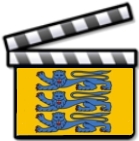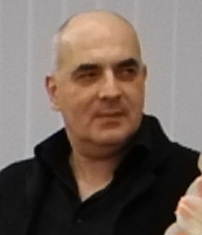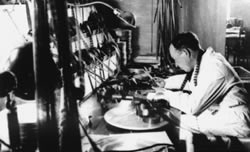
This is the list of war films produced in Estonia during the period of independence from 1918 to 1940 and from 1991 and beyond. The first Estonian war film was produced in 1927. [1]

This is the list of war films produced in Estonia during the period of independence from 1918 to 1940 and from 1991 and beyond. The first Estonian war film was produced in 1927. [1]
| Estonian title | English title | Director | Genre | Producer | Notes | |
|---|---|---|---|---|---|---|
| 1927 | ||||||
| Noored Kotkad | Young Eagles | Theodor Luts | adventure | Siirius Film | The first film about the Estonian war of Independence. Mass scenes with more than 4000 soldiers. | |
| Estonian title | English title | Director | Genre | Producer | Notes | |
|---|---|---|---|---|---|---|
| 1933 | ||||||
| Eesti Vabariigi 15. aastapäeva paraad | The 15th Anniversary parade of the Republic of Estonia | review | Eesti Kultuurfilm | Military parade on the Square of Freedom in Tallinn. | ||
| 1935 | ||||||
| Kaitseliidu päevad Tallinnas | Defence League Days in Tallinn | review | Eesti Kultuurfilm | Defence Leagues summer days in Tallinn. | ||
| 1936 | ||||||
| Kaitseliidu Sakala manöövrid | Defence League Sakala Manoeuvres | review | Eesti Kultuurfilm | Military exercises in South-Estonia. | ||
| 1937 | ||||||
| Kindluste linn Narva | The Fortification City of Narva | review | Eesti Kultuurfilm | Narvas military strongholds and fortification systems. | ||
| 1938 | ||||||
| Ringkäik Sõjamuuseumis | Review in the Museum of War | review | Eesti Kultuurfilm | Educational review film about the Estonian Museum of War. | ||
| 1938 | ||||||
| Relvastatud rahvas | Armed Nation | adventure | Eesti Kultuurfilm | Propaganda film. | ||
| Võitluses sündinud, rahus kasvanud | Born in Fight, Raised in Peace | adventure | Eesti Kultuurfilm | Propaganda film. | ||
| 1939 | ||||||
| Au langenuile | Glory to the Fallen | documentary | Eesti Kultuurfilm | Monuments of the Estonian War of Independence. | ||
| Päev Sõjakoolis | A Day in the School of War | review | Eesti Kultuurfilm | Educational review film about the School of War. | ||
| Estonian title | English title | Director | Genre | Producer | Notes | |
|---|---|---|---|---|---|---|
| 1940 | ||||||
| Allveelaevad harjutustegevusel | Submarines on the Exercises | review | Eesti Kultuurfilm | The Estonian Navy submarine fleet on the military exercises. | ||
| Merevägi harjutustegevusel | Navy on the Exercises | review | Eesti Kultuurfilm | The Estonian Navy surface fleet on the military exercises. | ||
| Estonian title | English title | Director | Genre | Producer | Notes | |
|---|---|---|---|---|---|---|
| 1995 | ||||||
| Wikmani poisid | Wikman Boys | Vilja Palm | drama serial | Eesti Televisioon | A drama serial about the Wikman Private Gymnasium students from 1937 till their mobilization in 1944. . | |
| 1997 | ||||||
| Me elasime Eesti nimel | We Lived for Estonia | Andres Sööt | documentary | Monofilm | A film about the Estonian partisans fight against the Soviet occupation during and after the World War II. | |
| Estonian title | English title | Director | Genre | Producer | Notes | |
|---|---|---|---|---|---|---|
| 2000 | ||||||
| Meie sõdurid | Our Soldiers | serial | EDF | A propaganda serial about the armed forces of Estonia. | ||
| 2001 | ||||||
| Uue Eesti sõdurid | New Estonia's Soldiers | Erik Boltowski | review | Erik Boltowski EDF | A propaganda film about the 10th anniversary of the Estonian Defence Force restoration. | |
| 2002 | ||||||
| Nimed marmortahvlil | Names in Marble | Elmo Nüganen | adventure | Taska Productions | Based on an acclaimed 1935 novel about the War of Liberation that ensured Estonia's independence. The film tells about a group of young schoolboys heading to the front to fight the army of Soviet Russia. | |
| Baltic Eagle 2002 | Baltic Eagle 2002 | Erik Boltowski | review | Erik Boltowski EDF | A propaganda film about the Estonian Defence Forces military exercises. | |
| 2003 | ||||||
| Somnambuul | Somnambulance | Sulev Keedus | war drama | F-Seitse Kinotar | Autumn 1944, Estonia. Tens of thousands of people leave their homeland in fear of approaching Soviet frontline... | |
| Presidendi kaardivägi | The President's Guard | Erik Boltowski | review | Erik Boltowski EDF | Propaganda documentary about the Guard Battalion. | |
| 2004 | ||||||
| Rahuvägi | A Force For Peace | Erik Boltowski | review | Erik Boltowski EDF | Propaganda documentary about the Estonian Peacekeepers. | |
| Scoutspataljon | The Scouts Battalion | Erik Boltowski | review | Erik Boltowski EDF | Propaganda documentary about the Scouts Battalion. | |
| 2005 | ||||||
| Haukka Grupp | Haukka Group | René Vilbre | documentary | Ruut Pictures | A tragic story about hope, betrayal and double game, and how it all befell the Estonian spies who fought for their homeland. | |
| Võitlus sinimustvalge eest - Sinine | Fight for Blue-Black-White - Blue | Toomas Lepp | documentary | ETV | A documentary trilogy about the fight for the restoration of the independence. | |
| Võitlus sinimustvalge eest - Must | Fight for Blue-Black-White - Black | Toomas Lepp | documentary | ETV | A documentary trilogy about the fight for the restoration of the independence. | |
| Võitlus sinimustvalge eest - Valge | Fight for Blue-Black-White - White | Toomas Lepp | documentary | ETV | A documentary trilogy about the fight for the restoration of the independence. | |
| 2006 | ||||||
| Sinimäed | Blue Hills | Raimo Jõerand | documentary | Ruut Pictures | A story on the Estonian Legions defense against the Soviet Army in 1944 with an emphasis on its last stand in the region known as the Blue Hills of Estonia. | |
| Võidupüha Mereparaad | Victory Day Naval Parade | review | ETV | The Estonian Navy and NATO naval parade. | ||
| Tuletoojad | The Flame Of Victory | Erik Boltowski | review | Erik Boltowski EDF | Propaganda documentary about the Estonian Defence League. | |
| Täiskäik edasi | Full Speed Ahead | Erik Boltowski | review | Erik Boltowski EDF | Propaganda documentary about the Estonian Navy development. | |
| Mehed unustatud armeest | The Forgotten Soldiers | Kalle Käesel | documentary | Osakond | A documentary about a top secret Estonian Guard Company nr.4421. The unit existed from 1946 to 1963 in Nurnberg. | |
| 2007 | ||||||
| Scoutspataljon - Respekt | Scoutsbattalion - Respect | commercial | EDF | A short propaganda video for the Scoutsbattalion recruiting campaign. | ||
| 2008 | ||||||
| Detsembrikuumus | December Heat | Asko Kase | war drama | Ruut Pictures | A war drama film about the 1924 1 September Soviet coup attempt in Estonia. | |
| Estonian title | English title | Director | Genre | Producer | Notes | |
|---|---|---|---|---|---|---|
| 2015 | ||||||
| 1944 | 1944 | Elmo Nüganen | war drama | Taska Film | Estonian soldiers in both the Soviet Army and the German Army have to choose sides and thus fight against their fellow countrymen during World War II. | |

Tallinn is the capital and most populous city of Estonia. Situated on a bay in north Estonia, on the shore of the Gulf of Finland of the Baltic Sea, Tallinn has a population of about 461,000 and administratively lies in the Harju maakond (county). Tallinn is the main governmental, financial, industrial, and cultural centre of Estonia. It is located 187 km (116 mi) northwest of the country's second largest city, Tartu; however, only 80 km (50 mi) south of Helsinki, Finland, also 320 km (200 mi) west of Saint Petersburg, Russia, 300 km (190 mi) north of Riga, Latvia, and 380 km (240 mi) east of Stockholm, Sweden. From the 13th century until the first half of the 20th century, Tallinn was known in most of the world by variants of its other historical name Reval.

Haapsalu is a seaside resort town located on the west coast of Estonia. It is the administrative centre of Lääne County, and on 1 January 2020 it had a population of 9,375.
The Estonian resistance movement was an underground movement to resist the occupation of Estonia by Nazi Germany, 1941–1944 during World War II. Due to the unusually benign measures implemented in Estonia by the German occupation authorities, especially in contrast to the preceding harsh Soviet occupation of Estonia (1940–1941), the movement was slower to develop effective tactics on a wide scale than in other occupied countries.

Cinema of Estonia is the film industry of the Republic of Estonia. The motion pictures have won international awards and each year new Estonian films are seen at film festivals around the globe.

Oskar Luts was an Estonian writer and playwright.
Tallinnfilm is the oldest surviving film studio in Estonia. It was founded as Estonian Culture Film in 1931, and was nationalized in 1940 after Estonia was integrated into the Soviet Union. During the first year of Soviet Occupation (1940–1941) Eesti Kultuurfilm was taken over by the Communist Party and renamed Kinokroonika Eesti Stuudio. In 1942 during the German occupation the studio was renamed Kinokroonika Tallinna Stuudio and then renamed again as Tallinna Kinostuudio in 1947 by the Soviets. The Tallinn Film Studio was renamed Kunstiliste ja Kroonikafilmide Tallinna Kinostuudio in 1954 and in 1963 was renamed again Tallinnfilm.
German submarine U-479 was a Type VIIC U-boat built for Nazi Germany's Kriegsmarine for service during World War II. She was laid down at the Deutsche Werke in Kiel on 19 November 1942 as yard number 310, launched on 14 August 1943 and was commissioned on 27 October 1943 with Oberleutnant zur See Hans-Joachim Förster, a Knights Cross winner, in command. He was replaced shortly afterwards by Oberleutnant Friedrich-Wilhelm Sons.

Zaza Urushadze was a Georgian film director, screenwriter and producer.

Theodor Luts was an Estonian film director and cinematographer, brother of classic writer Oskar Luts. Theodor Luts was the first major figure of Estonian cinematography

The Estonian Culture Film was a state-subsidized movie studio established in Estonia in 1931 by the Ministry of Culture. During the first years of existence, the studio mostly distributed films.
Miss Estonia is a national Beauty pageant in Estonia. The main winners mostly competed at Miss Universe pageant.

Estonia, officially the Republic of Estonia, is a country by the Baltic Sea in Northern Europe. It is bordered to the north by the Gulf of Finland across from Finland, to the west by the sea across from Sweden, to the south by Latvia, and to the east by Russia. The territory of Estonia consists of the mainland, the larger islands of Saaremaa and Hiiumaa, and over 2,300 other islands and islets on the east coast of the Baltic Sea, covering a total area of 45,335 square kilometres (17,504 sq mi). Tallinn and Tartu are the two largest urban areas. The Estonian language is the official language and the first language of the majority of the population of 1.4 million.

Purge is a novel by Finnish-Estonian writer Sofi Oksanen, which has been translated into thirty-eight languages. Oksanen's third Finnish-language novel, Purge was published in 2008 and is based upon her original play of the same name, staged at the Finnish National Theatre in 2007.

The guerrilla war in the Baltic states was an insurgency waged by Baltic partisans against the Soviet Union from 1944 to 1956. Known alternatively as the "Forest Brothers", the "Brothers of the Wood" and the "Forest Friars", these partisans fought against invading Soviet forces during their occupation of the Baltic states during and after World War II. Similar insurgent groups resisted Soviet occupations in Bulgaria, Poland, Romania and Ukraine.

Tangerines is a 2013 Estonian-Georgian film written, produced, and directed by Zaza Urushadze. Set during the 1992–1993 War in Abkhazia, the film's themes span conflict and war, reconciliation, and pacifism. It was filmed in Guria, Georgia.
The tradition of Estonian animation dates back to the 1930s when the first experimental films were made. The only surviving short film from the era is Kutsu-Juku seiklusi (1931). After the Great Depression, World War II, and Soviet Occupation interrupted its development, Estonian animation was reborn in 1958. Elbert Tuganov founded a puppet film division Nukufilm in Tallinnfilm Studio. The first film was titled Peetrikese unenägu based on a Danish writer Jens Sigsgaard's children story Palle alene i verden. Joonisfilm an 2D and 3D animation division of Tallinnfilm was founded by Rein Raamat in 1971. Films like Põld (1978), nominee for Golden Palm at the Cannes Film Festival in 1979; Lend (1973), the winner of Special Jury Award at the Zagreb World Festival of Animated Films; the Suur Tõll (1980), 2nd place at Ottawa International Animation Festival in 1982 and Põrgu (Hell) (1983), the winner of FIPRESCI Prize and Special Jury Award at the Annecy International Animated Film Festival made Raamat the first internationally recognized Estonian animation director.
O2 is a 2020 Estonian-Latvian-Lithuanian-Finnish historical spy thriller film, directed by Margus Paju, starring Sampo Sarkala, Kaspars Znotiņš, Elmo Nüganen, Rein Oja and Tambet Tuisk. The film is about the Estonian intelligence officer Feliks Kangur tried to find out a traitor in the secret service in 1939, on the eve of Estonia losing its independence. The film was written by Tom Abrams, Tiit Aleksejev, Eriikka Etholén-Paju and Olle Mirme.
A list of films produced in Estonia ordered by year of release. For an alphabetical list of Estonian films, see Category:Estonian films

Hannes Walter was an Estonian war historian.